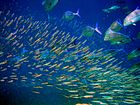Feeder fish
This article has multiple issues. Please help improve it or discuss these issues on the talk page. (Learn how and when to remove these messages)
|

Feeder fish is the common name for certain types of small, inexpensive fish commonly fed as live food to other captive animals such as predatory fishes (e.g. aquarium sharks, farmed salmon and tuna) or carnivorous aquarium fish (e.g. oscars, gar, grouper and rays), turtles, crocodilians and other piscivores that naturally hunt in fresh, brackish or salt water ecosystems (zoo animals such as grizzlies, water snakes, cetaceans, pinnipeds and penguins).
Advantages of using feeder fish
[edit]The species of fish usually sold as feeder fish are invariably some of the easiest fish for fishkeepers to rear and breed, such as common goldfish, guppies and fathead minnow. Typically, these species are tolerant of overcrowding and have a high fecundity and rapid growth rate. This makes it easy for fish farmers, retailers, and hobbyists to maintain large populations of these fish that can be sold at a much more affordable price than the more ornamental fish that require better conditions.
In some cases, species of predatory animals, typically large fish such as catfish, european perch and cichlids, but sometimes also animals such as freshwater turtles, are provided with feeder fish, because they accept them more readily than alternatives. Other animal keepers believe that feeder fish are particularly nutritious, being what one would expect their pets would eat in the wild; some others view feeder fish as a stimulating treat that encourages predatory animals to exercise their natural hunting behaviours.[1] Some animal keepers enjoy watching the hunting and eating techniques involved when predation occurs.
Disadvantages of using feeder fish
[edit]The primary drawback of feeding live fish is the possibility of contaminating the aquarium with bacteria and parasites. The inexpensive fish that are most likely to be used as feeders have almost always been reared extensively, which means they have been exposed to various pathogens. Feeder fish can, over time, expose predatory fish to skin and gill lice, parasitic intestinal worms, neonatal tetra illness, and a wide range of opportunistic parasites, germs, and viruses. Especially whitespot and velvet which is easy to spread between feeder fish if kept in an overcrowded tank.[3] Most predatory species that eat live fish can also be weaned onto dead alternatives. Some of the species used as feeder fish (goldfish and rosy red minnows) contain high quantities of thiaminase, an enzyme that destroys thiamine (vitamin B1) and when fed in large quantities can cause nutritional imbalances. When bred and held in an overcrowded or otherwise sub-optimal environment, they may also carry bacterial infections and parasites, which can be passed along to fish that consume them.[4][5] According to Jessica from " Thiamine Deficiency & fish ". Many products have been called back from the market because they contain thiamine. [6] If a deficiency is detected, many neurological disorders can start forming Thiamine deficiency has been associated with early life-stage death, neurological issues, crippling morbidities, and significant population losses of predatory fish. Since it was first discovered, chronic thiamine deficiency has been linked to fish species kept in aquariums.
Species use
[edit]Several fast-growing and hardy species are commonly sold and used as feeder fish. Depending on the locality, feeder fish may include:
- Low-quality, common livebearers, usually guppies, mosquito fish and platies
- Small cyprinids, particularly rosy red minnows and goldfish
- Undesirable livebearer and cichlid fry
- Female Siamese fighting fish
- Young tilapia
- Defective fry
Opinions within the hobby
[edit]Although the use of feeder fish is fairly common in the United States, in the United Kingdom it is much less commonplace, with aquarists and hobby magazines in Britain generally rejecting the use of feeder fish as being unnecessary and likely to cause health problems.[5][8]
See also
[edit]References
[edit]- ^ Milner, James (2017-10-21). "Should I Use Feeder Fish to Feed my Fish?". The Aquarium Club. Retrieved 2022-11-29.
- ^ "The Feeder Fish Debate: Are They Essential, Cruel, Or Dangerous?". www.wetwebmedia.com. Retrieved 2023-05-11.
- ^ "The Feeder Fish Debate: Are They Essential, Cruel, Or Dangerous?". www.wetwebmedia.com. Retrieved 2023-05-11.
- ^ Neale Monks. "Feeder Fish Mini-FAQ". Retrieved 2006-11-30.
- ^ a b Matt Clarke. "Stuff you need to know about feeding". Archived from the original on March 30, 2006. Retrieved 2006-11-30.
- ^ McCandless, David W. (2009-07-13), "Thiamine Deficiency in Mammals", Thiamine Deficiency and Associated Clinical Disorders, Contemporary Clinical Neuroscience, Totowa, NJ: Humana Press, pp. 17–30, doi:10.1007/978-1-60761-311-4_3, ISBN 978-1-60761-310-7, retrieved 2023-05-11
- ^ "Thiamine (Vitamin B1) Deficiency", Encyclopedia of Neuroscience, Berlin, Heidelberg: Springer Berlin Heidelberg, 2009, p. 4067, doi:10.1007/978-3-540-29678-2_5990, ISBN 978-3-540-23735-8, retrieved 2023-05-11
- ^ Matt Clarke. "Boy gets patent for live fish feeder". Archived from the original on 2015-01-22. Retrieved 2006-11-30.
External links
[edit]- Feeder Fish Mini-FAQ, the pros and cons — Review of the merits and problems of using feeder fish
- The Use of Live Feeder Fish in Saltwater Aquariums, by Tristan Gordon
- Leau Food

